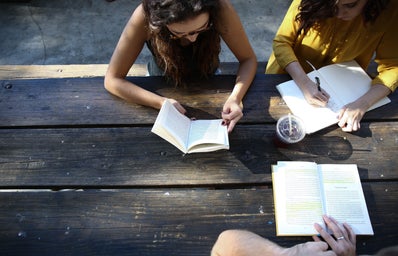For any artistic composition, whether that be a painting, dance, or short story, it is extremely difficult for the artist to garner inspiration. As a writer, this phenomenon is called “writer’s block” where even after beginning a story, it becomes hard to continue it or generate ideas let alone inspiration for it. I’ve experienced this many times, and sadly, it’s inevitable. However, I only got past my block because I had a sudden new wave of inspiration that always comes out of nowhere. The ability to draw inspiration from anything, whether that be the way in which two inanimate objects interact with each other or a mind-blowing story, is a common asset for many writers. It is also a useful tool for artists when generating ideas for a composition, but the way writers use it is specifically to tell a story. Though I’m no expert writer myself, I found that my ability to creatively think has helped me facilitate many of the storylines that I continue to write today (it’s a slow process). And I believe that explaining my personal method will help others find inspiration in nothing, and thus, turn it into something much more fruitful and meaningful through every means possible. turn it into something much more fruitful and meaningful through every means possible.
overthink it
I have a few ways to approach this, but first, there are a few ground rules. I’m sure many of us have been told by a teacher to not overthink it, whether that be guidelines for a project or taking a test. But neither art nor writing is restrictive and trapped within a strict binary; the entire appeal is that they are mediums of pure expression and freedom. So, I respectfully disagree with those teachers: overthink it. Overthink everything. Whenever I take a look at a situation and think of every possible outcome, whether it be the cause or the effect, I always have a slew of options to choose from when I finally know what direction I want it to go. Break every binary. Shatter every rule. It’s okay if things don’t make sense at first. When I put this into practice, I take a situation that already exists, whether it be in real life, from a piece of media, or even from a psychology experiment. Recently, I wrote a research paper arguing that morality is not innate to humans and that no one is born with a sense of good and evil, and I cited a psychology experiment that tested the moral perception of good and evil in children. The psychologist showed a puppet show to a 3-month-old toddler where there was a green otter, a blue otter, and a penguin. The penguin was dribbling a basketball, and it fell out of his hands. When it rolled over to the blue otter, he took the basketball and played with it by himself instead of sharing. The same scenario was reset, and this time it rolled to the green otter, who shared the basketball with the penguin instead of playing with it by himself. The toddler was then told to choose between the green otter and the blue otter, and he chose the green otter because that otter was dubbed “good” while the blue otter was dubbed “evil.” I thought it was extremely unfair to even dress up the scenario in such a way, because real life is much more complicated than that. What if the penguin and the blue otter made some agreement to share the basketball and take turns with it? What if the penguin didn’t even want to play with the ball anymore? Therefore, no one was good or evil in the first place. What if the blue otter had a brother that he used to play basketball with, but he tragically passed away, and seeing that basketball roll over to him reminded him of those times? There’s always more to the situation than what we initially see, and that’s a fact of life. Sometimes overthinking it might even get me right on the mark, but that’s not necessarily the goal. What I do is train my mind to think outside the box, thinking of every possible outcome, so that I have options whenever I’m unsure of the direction I want something to take. This is especially good when writing stories, because one of the main reasons that “writer’s block” even happens is because writers don’t know what should happen next in their stories or how to get from point A to B in a way that makes sense. But that’s the thing: nothing is going to make sense to be a genius work from the get-go, so there’s no use fearing the end result. The second ground rule is to not be afraid; just start writing literally anything and see where it takes you. This is easier said than done, but I find myself standing much further than where I started whenevr I just get started anyway. I know I have plenty of time to go back and change things later, but when it comes to writing stories, confining myself within an outline never helps me get further. It’s good to know what happens next, because that’s the end goal, but an outline is not going to come up with what happens in between. That’s up to you to figure out, and sometimes the best way to even do that is to just get started.
inextricably linked
To actually get inspiration from practically nothing, I first need to look at the world around me and understand that everything is connected; everything can be given a story. Doing this on living beings like humans or animals is a little too easy, so it’s good practice to do it on inanimate objects. Let’s take two trees that are next to each other in a forest, for example. How did they get there? Their seeds were probably blown away in the wind, kicked around by some animal, or carried in a small stream formed by rainwater, and in some way, they ended up right next to each other. Fate? Could be. As the years passed, their branches grew, their roots held them in place, and together they flourished into the healthy and happy trees that stood tall against the test of time. What they couldn’t foresee was that their growth knew no boundaries, and eventually it would lead to them growing connected to each other. Their branches became intertwined, their leaves blowing in the same wind that brought them together so long ago. However, they didn’t realize that their relationship was slowly evolving from a mutual alliance to a strong dependency. Their roots and vines became twisted into one another, unable to let go. They shared everything and relied on each other to stay alive and to stand strong against the forces of nature that worked against them. It wasn’t long before they understood that one couldn’t live without the other, no matter what they desired. In the world that they lived in, this only seemed fair, but their alliance was born out of necessity, not desire. Freedom was something they no longer knew, and even if they wished for it, their growth could not be undone. So, they stood together against the test of time, allied by fate but not by hope, and together they remained for eternity. And when they finally fell, they too fell together. Whenever I construct a narrative and attach it to something, I’ve learned that it is imperative to think about the possible relationships things share with each other. Making inanimate objects into beings with lives, character, and a slight hint of consciousness can be the root of an extremely fruitful story, and that is a great first step towards getting something from nothing.
look within
Sometimes the best source of inspiration is one’s own personal life, whether it’s from experiences one has had or personal traits that cause one to interact with others in a certain way. This mainly helps with character building more than anything else, but it’s important to understand characters in a story in every possible aspect so that it’s easier to answer this question: What would they do? To help with that, I created a personal page where I wrote down the majority of my outlooks on life in all of its aspects. I noted down the things that I don’t understand and why, and the things that I personally believed in, as well as what I thought to be right and wrong. Personally, I found that many of the characters I wrote, especially my main characters, were extensions of myself, and their interactions with others as well as the reasoning behind their choices largely matched some of the decisions I’ve made in my life. This may also be because I have trouble understanding that characters are always their own people, and I don’t have to make sense of their actions or personally agree with them. But for someone who has no experience and has chosen to learn how to write through their own personal exploration, this was a great start.
Finding inspiration in a place where there is no motivation or direction is extremely difficult, sometimes even impossible. It’s easy to fall into writer’s block when one runs out of ideas, but one should also learn to draw inspiration from everything around them, even in most mundane specimens, to keep their story going till the very end. Throughout the time that I’ve been writing stories, I’ve learned that it’s best to overthink everything and to give myself options when I don’t know which direction to go. Attaching a narrative to two unlikely beings, living or not, can prove fruitful in generating narratives and garnering inspiration from practically nothing. And finally, when all else fails, I look within myself, my beliefs, and my experiences, and see what it is that I can extend to my characters and even my narratives. This can also extend to fine art, as an artist should think about how ideas can be symbolized through imagery. It comes down to how an image can speak a thousand words, or how a story can paint a thousand pictures. Inspiration for ideas and stories can come from almost anywhere, and sometimes there’s no harm in garnering evidence from existing stories, movies, shows, or media in general. That’s how I’ve been able to move past my writer’s block almost every single time, and that’s how you can get something meaningful from nothing.


